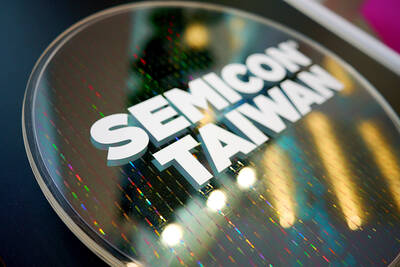The leading standard that connects PCs and digital displays will move to consumer devices in the next four years, research firm In-Stat/MDR predicted last week.
Digital Visual Interface (DVI) was developed by a group of companies led by Intel Corp, the now defunct Compaq Computer Corp, Fujitsu Ltd, Hewlett-Packard Co, International Business Machines Corp, NEC Corp and Silicon Image Inc.
The interface was introduced in 1999, and has been slow to take off. The one exception is Japanese-made digital camcorders that hook up directly to computers, digital flat-screen displays and digital television sets.
"The idea behind the spec was that since PCs produce digital output, and digital displays can accept digital input, it made sense to develop a digital connection in order to avoid any digital-to-analog and analog-to-digital conversions along the way," said Brian O'Rourke, a senior analyst with In-Stat/MDR.
Computer displays and televisions are making the move to digital. The latest flat-panel liquid-crystal-display computer screens and televisions are digital. There are now around 60 million subscribers to digital pay-TV services around the world, In-Stat/MDR reports, and that figure will grow to over 83 million by 2006. The companies that provide digital content for these services and for the Internet prefer DVI as it offers anti-piracy features, In-Stat's report found.
"Content providers especially liked the fact that DVI had high-bandwidth content protection," O'Rourke said. "Content providers in turn influenced service providers and consumer electronics manufacturers to consider DVI among their interface choices."
The In-Stat report said that this year more digital television makers are interested in DVI, and forecasts that over the next four years, the number of devices with DVI interface will grow at 100 percent annually.
Taiwan is a major supplier of digital consumer devices such as DVD players, DVD recorders and set-top boxes. Taiwan is also the world's leading manufacturer of notebook computers, accounting for more than 50 percent of global market share, said the Market Intelligence Center. Until now, local manufacturers have concentrated on low-end DVI products such as cables and connectors.
The move to consumer electronics will not slow down the growth of DVI in the notebook and desktop PC market, the report said. LCD projectors also use DVI connectors, allowing mobile business executives to use their notebooks to give presentations in meeting rooms. And those who use a notebook as their primary work PC can hook up to an office LCD monitor if they need a bigger screen.
"This should be enough to push DVI to 17 percent penetration of the notebook PC market by 2006," O'Rourke said.
Apple Computer Inc has led the computer market in implementing DVI. The company has a standard DVI port on its Power Mac G4 desktop, and Titanium PowerBook G4 notebook PCs. Apple CEO Steve Jobs announced earlier this year at the launch of the LCD iMac that the company was abandoning CRT monitors and moving totally to LCD.
It makes sense that Apple was the first PC manufacturer to implement DVI, O'Rourke said.
* Computer displays and televisions are making the move to digital.
* The latest flat-panel LCDs computer screens and televisions are digital.
* There are now around 60 million subscribers to digital pay-TV services around the world.

LIMITED IMPACT: Investor confidence was likely sustained by its relatively small exposure to the Chinese market, as only less advanced chips are made in Nanjing Taiwan Semiconductor Manufacturing Co (TSMC, 台積電) saw its stock price close steady yesterday in a sign that the loss of the validated end user (VEU) status for its Nanjing, China, fab should have a mild impact on the world’s biggest contract chipmaker financially and technologically. Media reports about the waiver loss sent TSMC down 1.29 percent during the early trading session yesterday, but the stock soon regained strength and ended at NT$1,160, unchanged from Tuesday. Investors’ confidence in TSMC was likely built on its relatively small exposure to the Chinese market, as Chinese customers contributed about 9 percent to TSMC’s revenue last

With this year’s Semicon Taiwan trade show set to kick off on Wednesday, market attention has turned to the mass production of advanced packaging technologies and capacity expansion in Taiwan and the US. With traditional scaling reaching physical limits, heterogeneous integration and packaging technologies have emerged as key solutions. Surging demand for artificial intelligence (AI), high-performance computing (HPC) and high-bandwidth memory (HBM) chips has put technologies such as chip-on-wafer-on-substrate (CoWoS), integrated fan-out (InFO), system on integrated chips (SoIC), 3D IC and fan-out panel-level packaging (FOPLP) at the center of semiconductor innovation, making them a major focus at this year’s trade show, according

DEBUT: The trade show is to feature 17 national pavilions, a new high for the event, including from Canada, Costa Rica, Lithuania, Sweden and Vietnam for the first time The Semicon Taiwan trade show, which opens on Wednesday, is expected to see a new high in the number of exhibitors and visitors from around the world, said its organizer, SEMI, which has described the annual event as the “Olympics of the semiconductor industry.” SEMI, which represents companies in the electronics manufacturing and design supply chain, and touts the annual exhibition as the most influential semiconductor trade show in the world, said more than 1,200 enterprises from 56 countries are to showcase their innovations across more than 4,100 booths, and that the event could attract 100,000 visitors. This year’s event features 17

Hon Hai Precision Industry Co (鴻海精密), which assembles servers for Nvidia Corp, yesterday said that revenue last month rose 10.61 percent year-on-year, driven by strong growth in cloud and networking products amid continued front-loading orders for artificial intelligence (AI) server racks. Consolidated revenue expanded to NT$606.51 billion (US$19.81 billion) last month from NT$548.31 billion a year earlier, marking the highest ever in August, the company said in a statement. On a monthly basis, revenue was down 1.2 percent from NT$613.86 billion. Hon Hai, which is also a major iPhone assembler, added that its electronic components division saw significant revenue growth last month, boosted